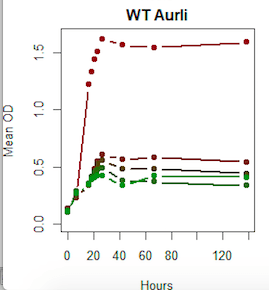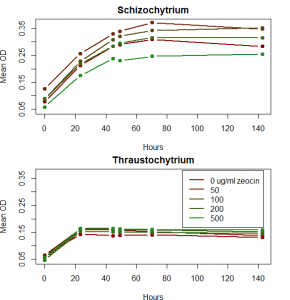Antibiotic sensitivity varies substantially among species of labyrinthulomycetes.
Inhibitory concentrations of various antibiotics for diverse labyrinthulomycetes. ns indicates ‘not sensitive’. Tet=tetracycline, Dox=doxycycline, Nour=nourseothricin, Hyg=hygromycin B, G418=geneticin, Bek=bekanamycin, Kas=kasugamycin, Blast=blasticidin, Zeo=zeocin. Also screened and uniformly not inhibitory: penicillin, ampicillin, kanamycin, streptomycin, spectinomycin, carbenicillin, neomycin, puromycin. * indicates data from Sakaguchi et al. 2012.
| Tet | Dox | Nour | Hyg | G418 | Bek | Kas | Blast | Zeo | ||
| Oblongichytrium sp.# | ||||||||||
| SEK600 | 250 | 2000 | 100 | 200 | ||||||
| SEK600 | 400 | 2000 | 50 | 200 | 80 | |||||
| SEK707 | 400 | 2000 | 100 | 200 | 80 | |||||
| SEK708 | 50 | ns | 50 | 20 | 80 | |||||
| SEK711 | 50 | 2000 | 100 | 20 | 80 | |||||
| Aurantiochytrium limacinum | ||||||||||
| SR21# | 250 | 2000 | 100 | 200 | 80 | |||||
| ATCC MYA-1381$ | 100 | 100 | 100 | 200 | 500 | ns | 50 | 15 | ||
| mh0186* | ns | 2000 | 2000 | 100 | 1000 | |||||
| Schizochytrium aggregatum | ||||||||||
| ATCC 28209$ | 100 | 100 | 100 | 800 | 500 | 50 | ||||
| 204-06 m* | 2000 | 2000 | ns | ns | ||||||
| Thraustochytrium aureum | ||||||||||
| ATCC 34304* | ns | 2000 | 2000 | 100 | ns | |||||
| Parietichytrium | ||||||||||
| TA04Bb* | 2000 | 2000 | 800 | ns | ||||||
| Labyrinthula | ||||||||||
| KIE13% | ns | ns | 50 | ns | ||||||
| Aplanochytrium | ||||||||||
| PBS06$ | 100 | 100 | ||||||||
| PBS07$ | 100 | 100 | ||||||||
This data was generated by Collier, Rest, et al. as part of a grant from the Gordon and Betty Moore Foundation.
#Honda et al. data: Strains were pre-cultured in 25ml of dGPY medium or Sea Act I medium in a 125 ml Erlenmeyer flask at 25C for 5 days. Growth assays were performed in 24 well plates (lumox multiwell plate/Sarstedt). Each well contained 1ml of dGPY and an appropriate concentration of an antibiotic. 10μl of pre‐cultured cells were transferred into each well and the plates were incubated at 25C. Optical density was measured on a plate reader (PerkinElmer ARVO MX 1420) at 610nm and at 25 points in each well 0h, 24h, 48h, 72, and 7days after inoculation.
$Collier, Rest et al. data: Strains were pre-cultured in 25ml of full-strength 790 medium (Schizochytrium and Aurantiochytrium) or 10% 790 medium (Aplanochytrium) in a 125 ml Erlenmeyer flask at 25C for 5 days. Growth assays were performed in 96 well plates. Each well contained 200 ul of growth medium and an appropriate concentration of an antibiotic. 10μl of pre‐cultured cells were transferred into each well and the plates were sealed and incubated at 25C, with shaking at 3,000 rpm for Schizochytrium and Aurantiochytrium. Optical density was measured on a plate reader (Tecan Inifinite F500) at 610nm and at 25 points in each well 0h, 24h, 48h, 72, and 7days after inoculation.
%Reusch, Brakel et al. data: Labyrinthula strains were cultivated on serum seawater medium (1L miliQ water, 12g agar agar, 1g glucose, 0.1 g yeast extract, 0.1 g peptone, 10 ml horse serum and 25 ml penicillin-streptomycin, 25 g Instant Ocean) at 22°C in dark. Labyrinthula growth assays were performed in 6-well plates. In the middle of each well an agar disc from the growing front of a Labyrinthula culture growing on agar was placed upside down. Then the wells were filled by 2 ml of serum seawater medium including the respective antibiotic (method modified from Martin et al. 2009). The chambers were incubated at 22°C or 25°C in dark. After 24, 48 and 96 hours , cultures were inspected under a microscope with 60x magnification. The whole area of the well was inspected, and the area of highest cell concentration was photographed and cell density was categorized according to the following categories: (0) full coverage of bottom by cells, (1) cells in aggregates visible, (2) singular cells visible, (3) total absence.
Examples of microtiter plate growth curves showing zeocin sensitivity of Aurantiochytrium limacinum and resistance of Schizochytrium aggregatum and Thraustochytrium aureum


